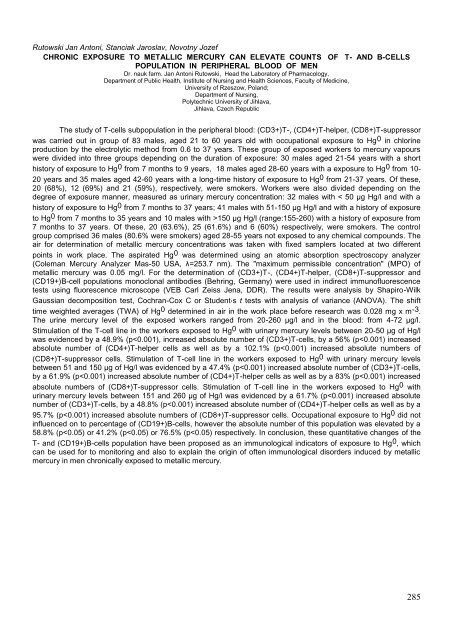ÐбÑÑник Ñез XVI ÐÑжнаÑодно медиÑного конгÑеÑÑ ÑÑÑденÑÑв Ñа ...
ÐбÑÑник Ñез XVI ÐÑжнаÑодно медиÑного конгÑеÑÑ ÑÑÑденÑÑв Ñа ...
ÐбÑÑник Ñез XVI ÐÑжнаÑодно медиÑного конгÑеÑÑ ÑÑÑденÑÑв Ñа ...
You also want an ePaper? Increase the reach of your titles
YUMPU automatically turns print PDFs into web optimized ePapers that Google loves.
Rutowski Jan Antoni, Stanciak Jaroslav, Novotny Jozef<br />
CHRONIC EXPOSURE TO METALLIC MERCURY CAN ELEVATE COUNTS OF T- AND B-CELLS<br />
POPULATION IN PERIPHERAL BLOOD OF MEN<br />
Dr. nauk farm. Jan Antoni Rutowski, Head the Laboratory of Pharmacology,<br />
Department of Public Health, Institute of Nursing and Health Sciences, Faculty of Medicine,<br />
University of Rzeszow, Poland;<br />
Department of Nursing,<br />
Polytechnic University of Jihlava,<br />
Jihlava, Czech Republic<br />
The study of T-cells subpopulation in the peripheral blood: (CD3+)T-, (CD4+)T-helper, (CD8+)T-suppressor<br />
was carried out in group of 83 males, aged 21 to 60 years old with occupational exposure to Hg 0 in chlorine<br />
production by the electrolytic method from 0.6 to 37 years. These group of exposed workers to mercury vapours<br />
were divided into three groups depending on the duration of exposure: 30 males aged 21-54 years with a short<br />
history of exposure to Hg 0 from 7 months to 9 years, 18 males aged 28-60 years with a exposure to Hg 0 from 10-<br />
20 years and 35 males aged 42-60 years with a long-time history of exposure to Hg 0 from 21-37 years. Of these,<br />
20 (68%), 12 (69%) and 21 (59%), respectively, were smokers. Workers were also divided depending on the<br />
degree of exposure manner, measured as urinary mercury concentration: 32 males with < 50 µg Hg/l and with a<br />
history of exposure to Hg 0 from 7 months to 37 years; 41 males with 51-150 µg Hg/l and with a history of exposure<br />
to Hg 0 from 7 months to 35 years and 10 males with >150 µg Hg/l (range:155-260) with a history of exposure from<br />
7 months to 37 years. Of these, 20 (63.6%), 25 (61.6%) and 6 (60%) respectively, were smokers. The control<br />
group comprised 36 males (80.6% were smokers) aged 28-55 years not exposed to any chemical compounds. The<br />
air for determination of metallic mercury concentrations was taken with fixed samplers located at two different<br />
points in work place. The aspirated Hg 0 was determined using an atomic absorption spectroscopy analyzer<br />
(Coleman Mercury Analyzer Mas-50 USA, λ=253.7 nm). The "maximum permissible concentration" (MPO) of<br />
metallic mercury was 0.05 mg/l. For the determination of (CD3+)T-, (CD4+)T-helper, (CD8+)T-suppressor and<br />
(CD19+)B-cell populations monoclonal antibodies (Behring, Germany) were used in indirect immunofluorescence<br />
tests using fluorescence microscope (VEB Carl Zeiss Jena, DDR). The results were analysis by Shapiro-Wilk<br />
Gaussian decomposition test, Cochran-Cox C or Student , s t tests with analysis of variance (ANOVA). The shift<br />
time weighted averages (TWA) of Hg 0 determined in air in the work place before research was 0.028 mg x m -3 .<br />
The urine mercury level of the exposed workers ranged from 20-260 µg/l and in the blood: from 4-72 µg/l.<br />
Stimulation of the T-cell line in the workers exposed to Hg 0 with urinary mercury levels between 20-50 µg of Hg/l<br />
was evidenced by a 48.9% (p
















